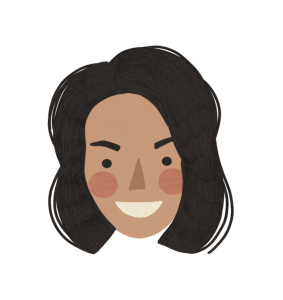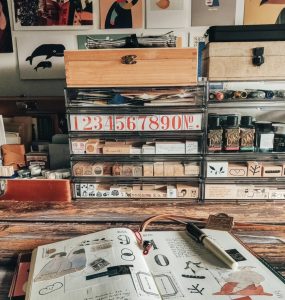Reader’s Question:
How did you start journaling in the first place? How do you split your time between other parts of life (daily tasks, work, responsibilities, etc.) and journaling? How do you design your time-tracker journal, and how can I create my own?
— from Instagram comments
***
When I uploaded an Instagram story about my time-tracker journal and an Instagram picture about my planner a few weeks ago, some of you asked some questions about journaling and making a time-tracker journal for yourself. Since it would be such a nuisance to type the answer on Instagram’s comment section, I decided to respond to those questions via this blog post. Hope this helps.
How did I start journaling?
I started journaling in the 1st grade of elementary school. It started out when my mother bought me a diary with a lock (the cutest thing!) and since then, I never stopped writing in my journals. I have quite a huge pile of journals at the moment, all those handwritings from early elementary school days throughout the rest of my childhood, from my adolescence to my twenties. And sometimes, I reread them: amazed at how much I’ve grown throughout the years.
I guess writing (and mostly journaling), has always been my go-to outlet for self-discovery. A few years ago, I wrote this post about why I write and why it has such a profound effect on me, so you can visit that post if you’re interested to know more about how I chose writing as my outlet of expression (or, on how writing chose me).
How do I split my time between journaling and other parts of life (daily tasks, work, responsibilities, etc.)?
Okay, here’s the thing: journaling, writing, and other creative pursuits—whether it’s drawing, painting, learning how to make illustrations–are the things that I need in life. When people talk about self-care, they might talk about taking a vacation, traveling, pampering themselves, eating healthy food, going to the gym, having a wonderful time with friends and families, or doing other things that make them feel happy and fulfilled. For me, having the time to be creative (and to create) is my way to take good care of myself. It feeds my soul.
When I’m stressed, sad, facing problems, agitated, or not feeling well, having my creative time is the thing that lifts me up. It could be as simple as reading a good book, trying a new recipe, drawing, writing a poem, or simply journaling and dumping my thoughts and feelings on the pages. For me, creative time equals self-care, and having my creative time makes me feel happy, empowered, (somewhat) artistic, and productive.
Having the time to be creative is my way to take a good care of myself. I need it. It’s crucial for my well-being.
I always feel the most productive when I am having a creative time. No matter how busy I am with work, no matter how excited I am about my professional achievements, no matter how many to-do lists and responsibilities I ticked off, at the end of the day, the thing that matters the most to me is how I’ve spent my creative time and what I’ve created that day.
I’m not saying that professional achievements or performing well at work don’t matter as much, but it’s also crucial for me to know that there’s an achievement that is mine; and mine alone. It’s not about being (or looking) busy, getting praise, a salary, a bonus, contributing to a team, or pleasing a client. It’s about exploring my creativity and be content with that—knowing that I am the only person who knows what I have done today, or how much I have grown since yesterday.
With that being said, let’s move on to the question: how do I split my time between work, daily tasks, and journaling?
In the old days, this was how I would do it: when planning my day, I would list down all my work responsibilities, deadlines, meetings, daily tasks, house chores, appointments, etc. and then, when I could find an empty slot of time, I would allocate that slot for my creative time.
Of course, this approach didn’t work for me.
Magically, I would always have more things to do, more emails to reply to, more work stuff coming in, more dishes to wash… and even if I could find an empty slot of time that day, usually I had been so exhausted from fulfilling my duties and responsibilities that I didn’t want to do anything else; let alone ‘being creative’.
So, these past few years, I changed the way I plan my day. Instead of listing down all my work responsibilities, deadlines, meetings, daily tasks, house chores, or appointments to then find an empty slot of time for my creative pursuits, I did the opposite. I would block a slot of time for my creative pursuit first (could be for around 30 minutes – 1 hour), and only then the rest of the empty slots can be filled with my work responsibilities, deadlines, meetings, daily tasks, or other appointments.
Usually, I block my early mornings for my first round of creative time (I called this time of the day my miracle morning, based on the book The Miracle Morning by Hal Elrod; and I think you should read this book as well!). I don’t mind waking up a bit earlier to have my slow and miraculous morning: making a cup of coffee, doing a 1-minute meditation, reading a book about drawing, sketching and doing some character studies for my illustrations, journaling, watching uplifting videos, or simply writing about the things I’d like to do/achieve that day.
I plan my day around my self-care, not the other way around. My commitments and responsibilities will fit themselves around it.
Surely, if there are still more unused time slots after this, I can use the time for whatever I want—but planning my day around my creative time (instead of planning my creative time around my day) does the trick for me. By doing this, I can make sure that I stay happy and creative, knowing that I will always have (and make) the time for my self-care routine, and my other responsibilities will fit around it.
Does it sound selfish?
Probably, but I see it this way: when I’m happy, I can also fulfill my responsibilities better. When I’m in a good mood, I am more energetic. I feel inspired and I feel more creative. So whether I’m working on a deadline, talking on the phone for a remote meeting, or doing house chores, I am doing those things in a healthy mental and emotional state. Thus, for me, it makes sense to always put my well-being first, which in my case, is about having my undisturbed creative time.
How did I design my time-tracker journal, and how to create your own?
I designed my time-tracker journal because I want to know whether I’m really busy or just busy being busy. I want to know how do I use up (or waste) my time in a day and what are the things I can achieve mostly from 6 am to 11 pm every day. Where does exactly my time go in a day?
Another thing was that I also want to track the time when I feel most productive and the time when I have an energy slump so I can plan my days better. By keeping a time-tracker journal for some time, I also hope that I could find out if there were some correlations between how I spend my time with my energy level and my overall mood.
For instance, there were days when I feel so tired and sleepy at around 2 pm – 4 pm, but there were also other days when I go through these ‘sluggish hours’ being productive, feeling inspired and energetic.
I wanted to know why this happened, and once knowing that (or at least have a good indication about why it happened), I wanted to know how I could have my productive 2 pm – 4 pm more often. By tracking my time, I wish I could see how to manage my energy better. (If you’re interested in the concept of managing energy to improve your performance, I would suggest the book The Power of Full Engagement by Jim Loehr and Tony Schwartz).
I created my time-tracker journal on a weekly insert I bought here and stamped the hours with this stamp set. Because I wanted to measure the correlation between how I spend my time and how it affects my mood and energy level, I decided to color-code my time-tracker with my KOI coloring brush pen.
- Pink is for a productive time when I feel creative and energetic. This includes the time when I work, replying to business emails, reading a non-fiction book, learning languages, drawing, exercising, writing, or doing other creative stuff. My creative time is counted as a productive time.
- Blue is for my non-productive time when I feel tired, sleepy, or lethargic. This includes the time of scrolling social media feed mindlessly, following threads and comments on a controversial Facebook status, taking a long nap, or feeling down, miserable, uninspired, or sick.
- Yellow is for my social & commuting time when I meet people, get on a bus, hop on a red-eye flight, attend a dinner party, have a catch-up lunch with friends, or delivering training and workshops.
This is how I formatted my time-tracker journal, but of course, you can do it however you like and adjust it to your needs. For instance, you can choose a different layout using a normal notebook, list down the hours from top to bottom, and write down the things you do next to it. You can also use color-coding to track other things you want to track in your life. It just happens that I want to track my energy level, so I decided to go with this tracking system.
Then, basically what I do with my time-tracker journal is as simple as writing down the things I do at a particular time of the day, and color code the hours with pink, blue, or yellow.
After keeping the time-tracker journal for more than 2 months, I can already see some patterns, such as:
- When my morning starts with a blue (i.e. I woke up feeling sluggish/tired/grumpy), 80% of the time, it will lead to more blues in the afternoon/evening. Knowing this, when I woke up with a blue, I put extra efforts to fix it: maybe treating myself to an extra hour of drawing instead of immediately replying to business emails, listening to cheerful songs to lift up my mood, or making pretty-looking oatmeal for breakfast.
- When I have a big lunch followed by a passive activity (reading, watching videos, etc.), I would also get blues between 2 pm – 4 pm. However, when I have a light lunch followed by hours of doing things (working, washing dishes, tidying my drawer, planning my to-do lists for the next day, journaling, etc.) I would not hit the blues.
- When I have loads of yellows on my day, 90% of the time, it will lead to a few hours of blues the next day. When I had to deliver a 3-day workshop a month back, I found out that the next 2 days following that 3-day workshop was filled with blues. I have always known, instinctively, that although I love meeting people, those interactions drained me up. I always feel the need to clam up and recharge before being able to be a social butterfly once more. The time-tracker journal confirmed this need. Thus, when I know I will have a big day full of work deadlines, I would decline any social get-together the day before. Or if I know I will have a full social calendar on the weekend, I would not set up a project deadline on the following Monday or Tuesday; knowing full-well that I would need to recuperate.
- When I work on a creative project from around 6 pm onwards, I would not feel hungry or crave a big dinner. Most of the time, I forgot about dinner altogether because I was too absorbed in the activity.
- When I go to bed after 11 pm, 80% of the time, I would wake up with blues the next morning.
- When I spend a lot of time mindlessly scrolling on social media (more than half an hour), the following hours will be blue.
I found it interesting (but would also understand if this sounds boring to some of you!), and couldn’t wait to see what other ‘revelations’ I could get in the next 2-3 months of keeping my time-tracker journal. For me, the journal also serves as an activity tracker, a mood tracker, a productivity tracker, and a tiny summary of my days.
Are you thinking of starting a time-tracker journal of your own? Why do you think you would need one? What are the things you want to track? How do you think you can get to know yourself better if you can track the way you spend your time every day? I would love to hear from you!
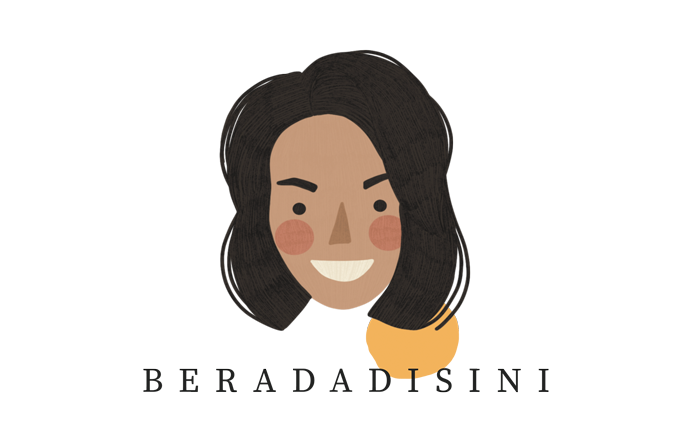

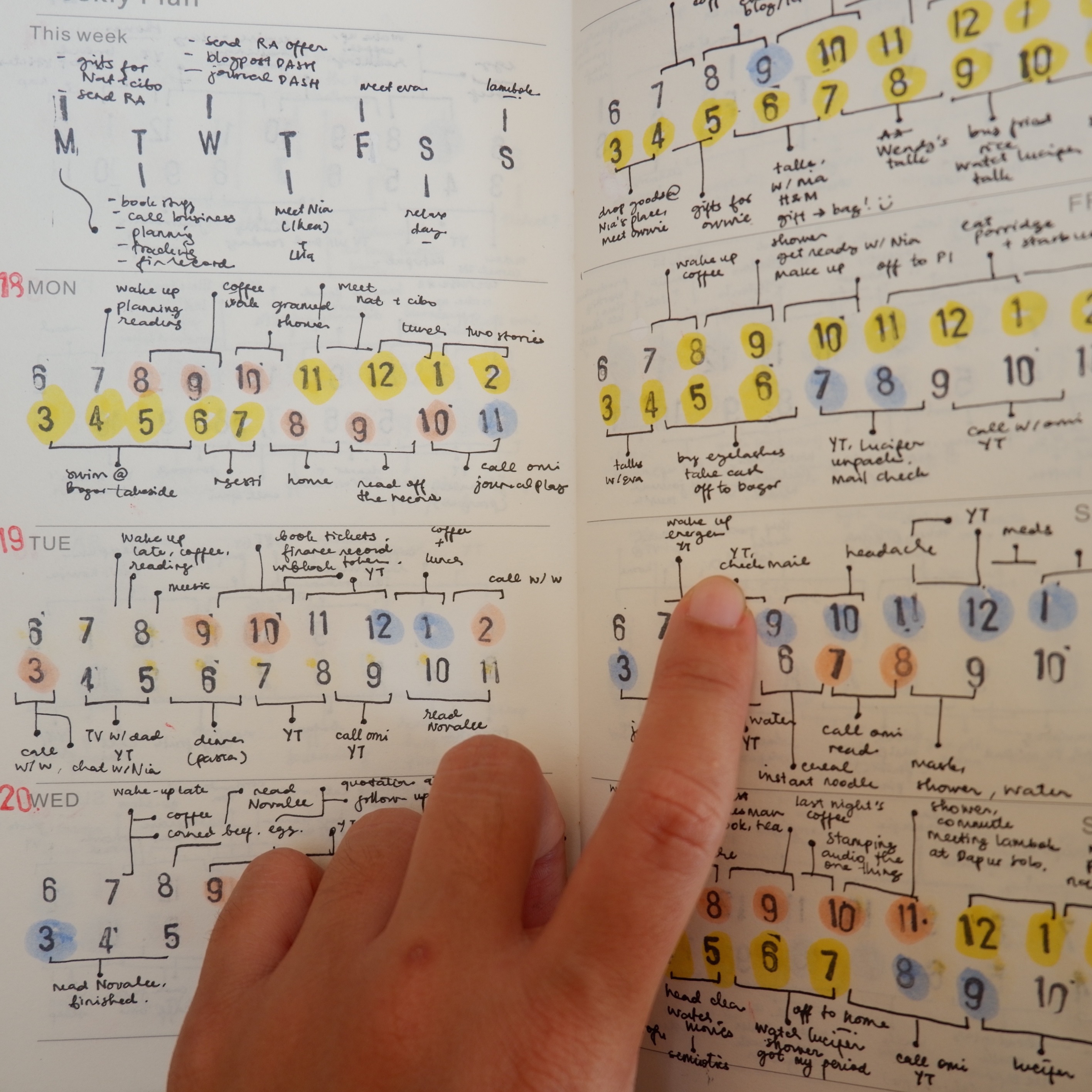
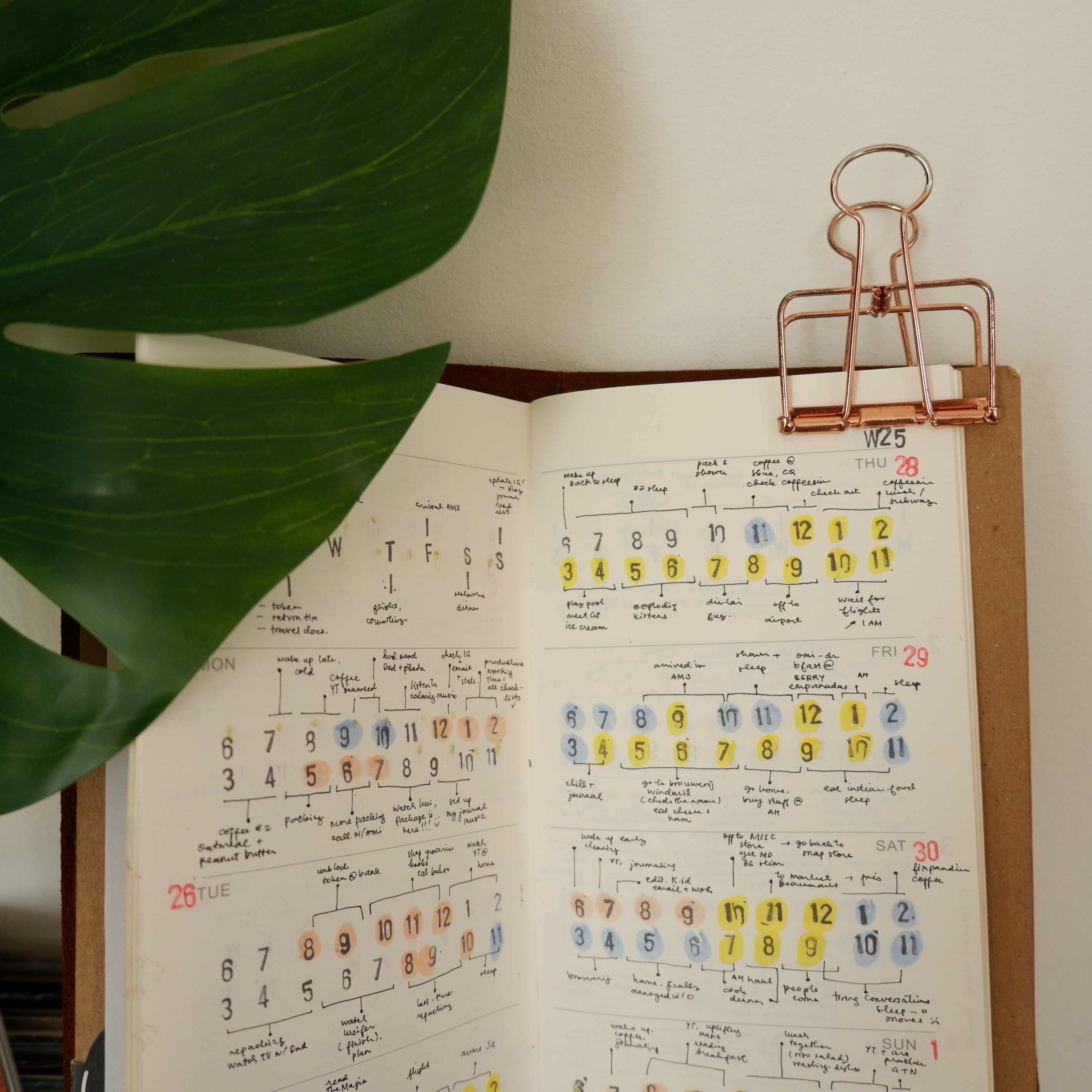
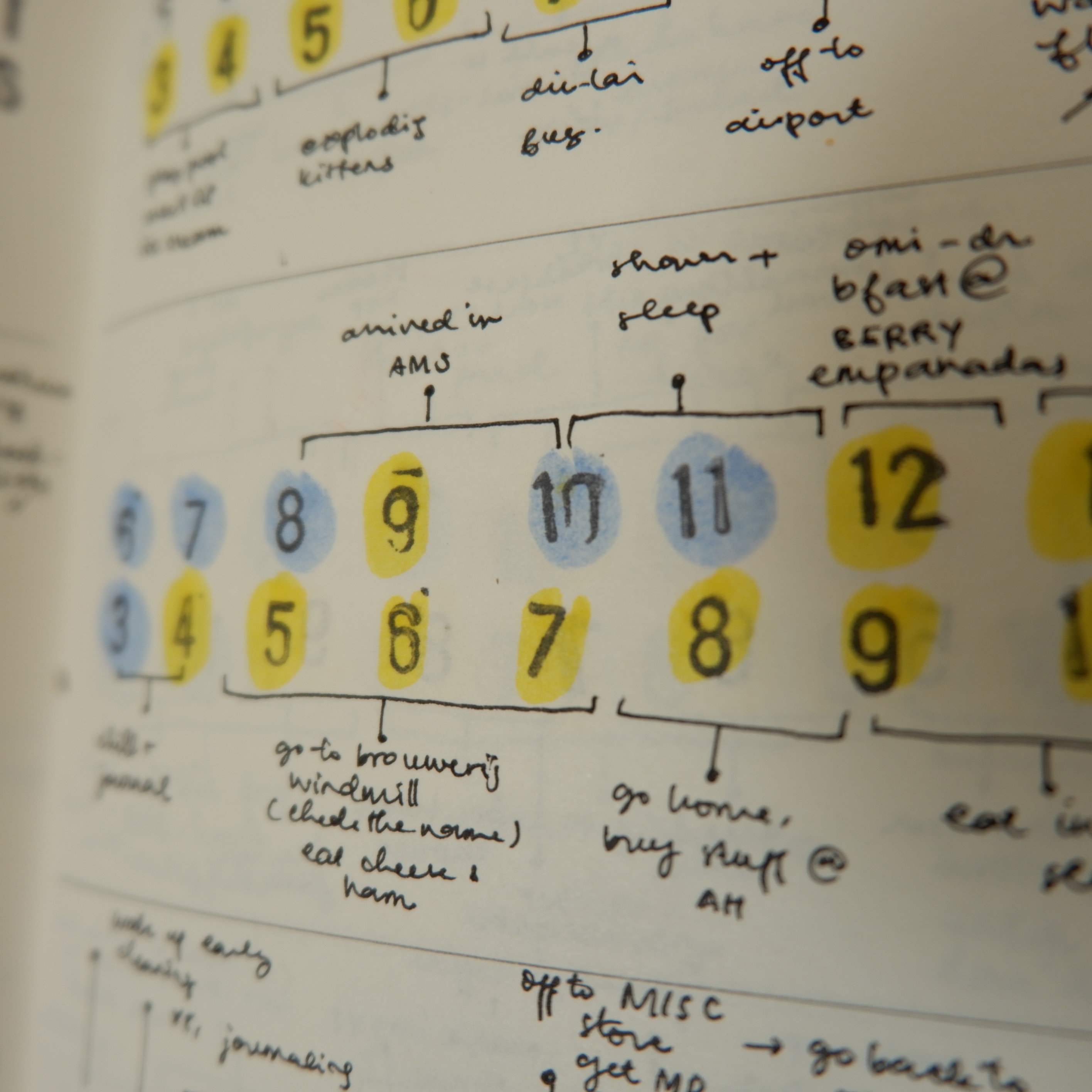



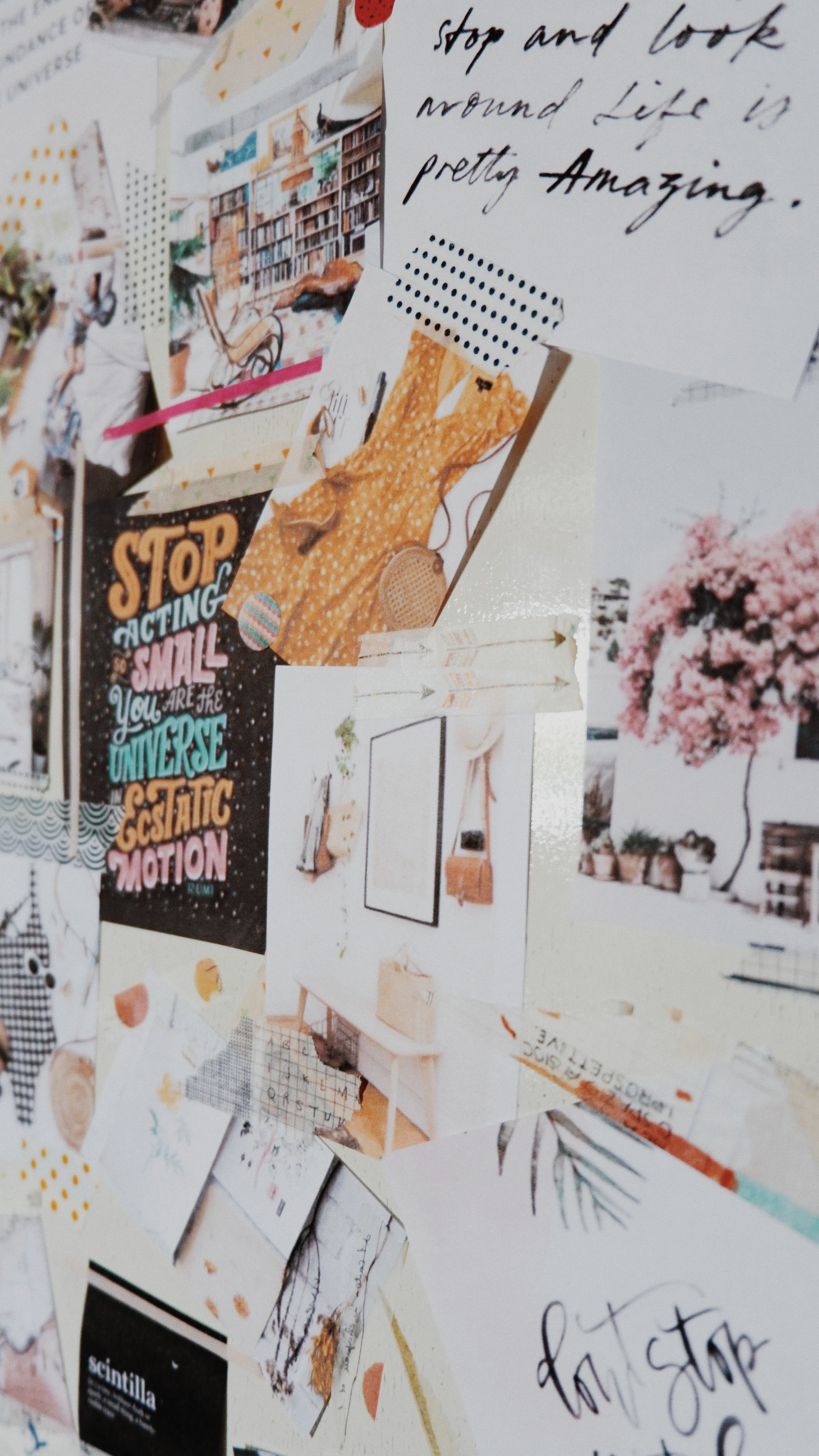
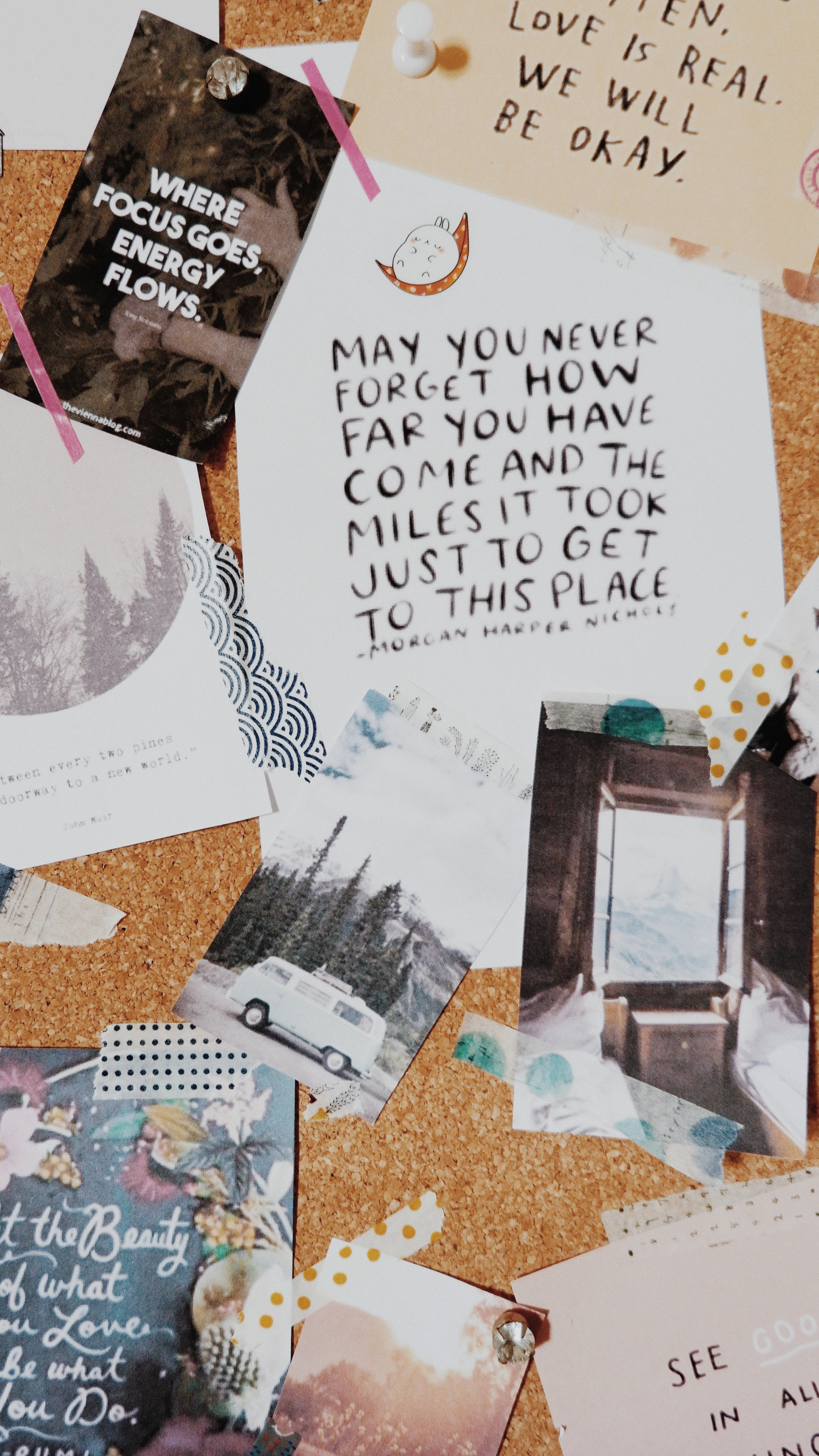

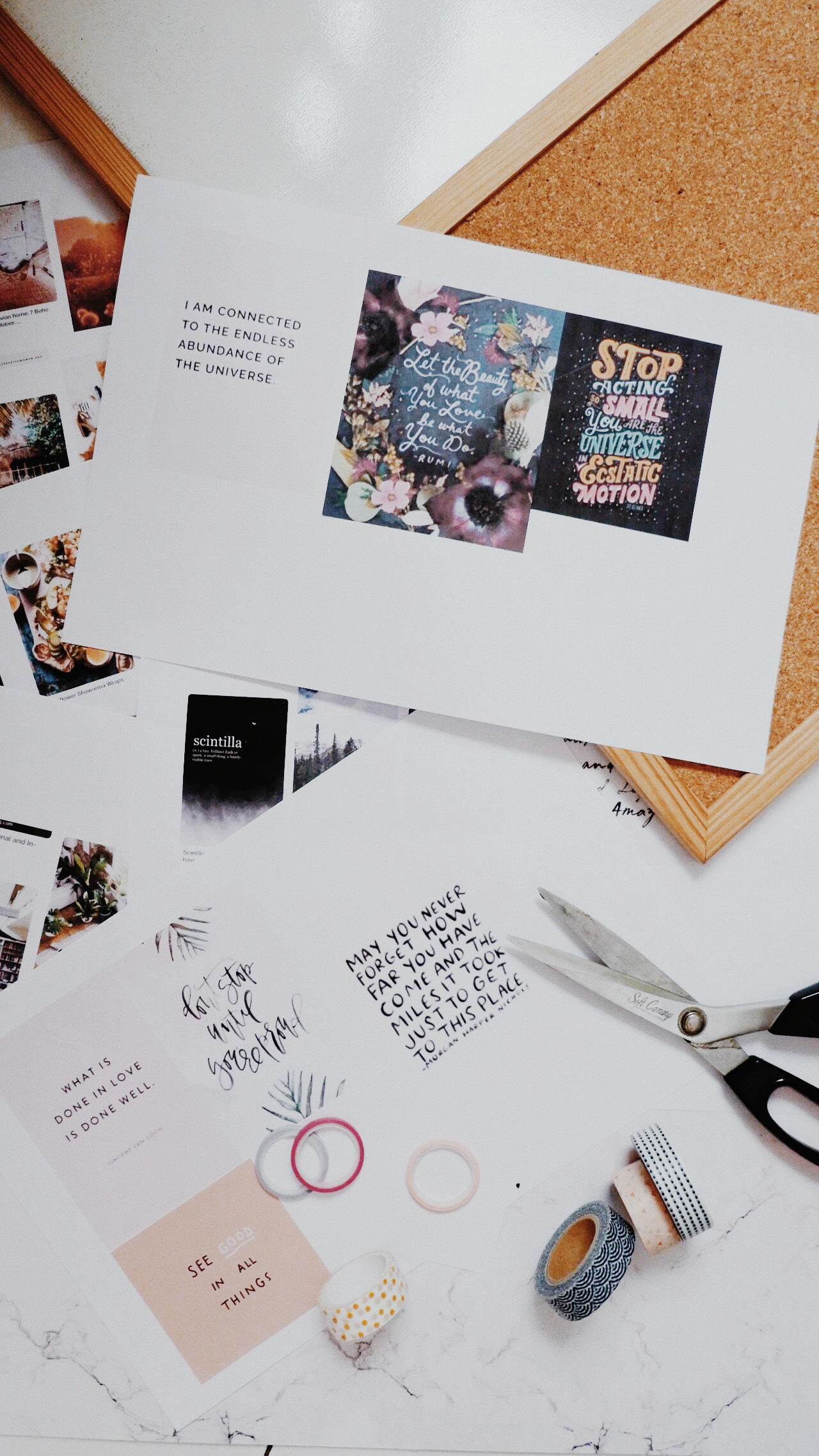
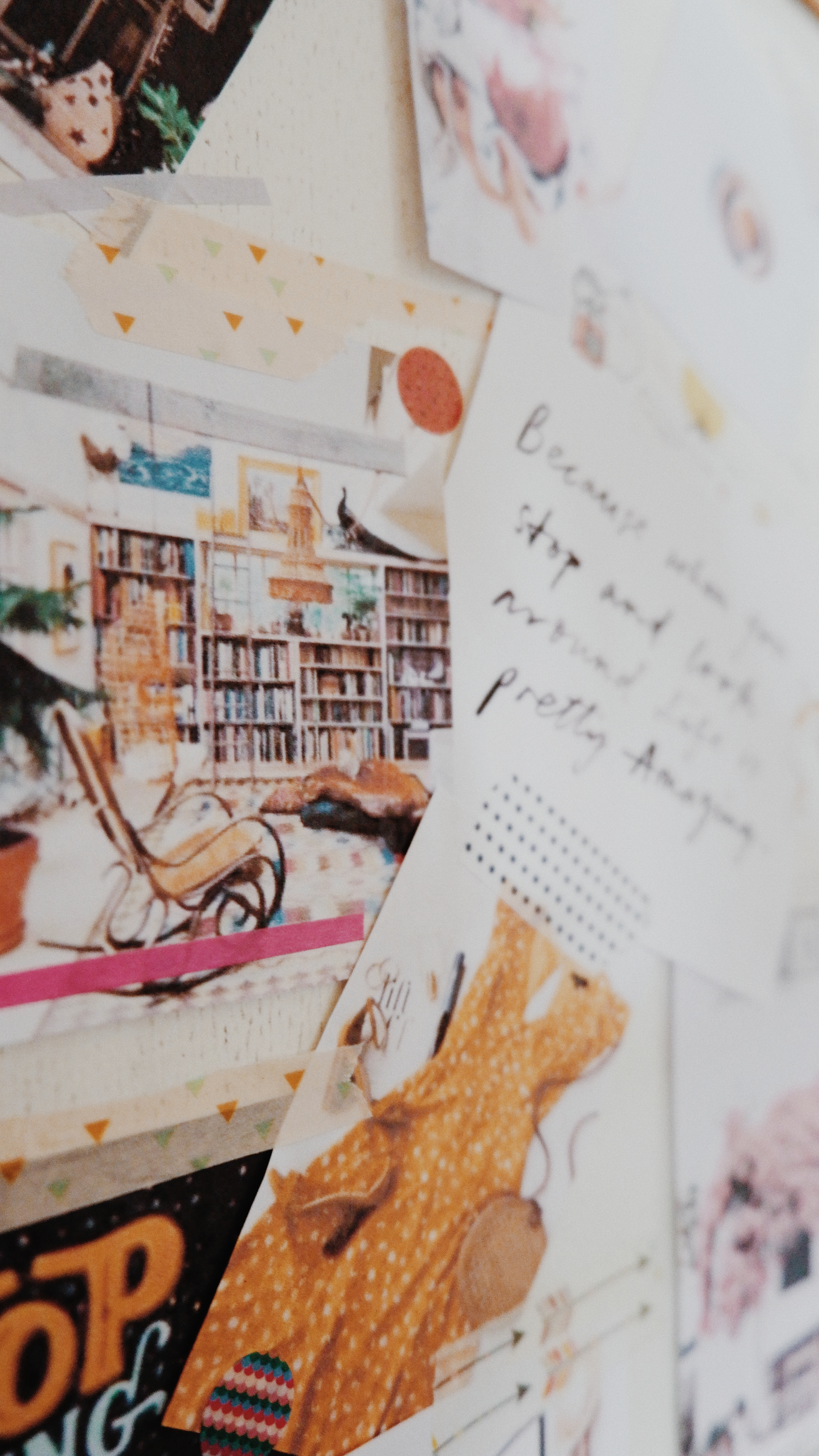
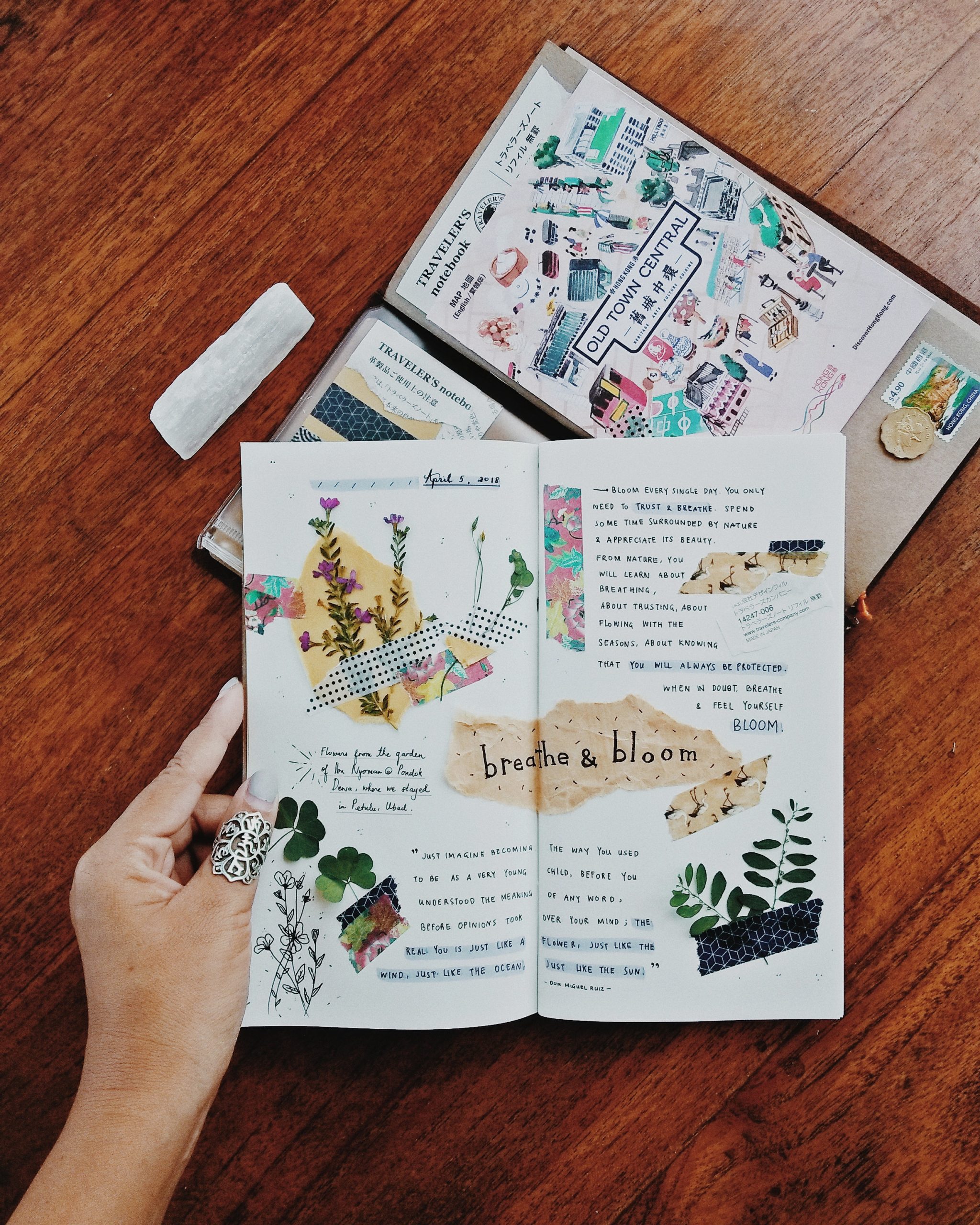




 In my case, when I started freelancing after leaving my corporate job a few years ago, I was surprised to find myself feeling low and unhappy. It was confusing. Wasn’t this my ideal kind of working condition? To work from anywhere, to work with clients I like, to work on projects I am inspired with? Then, why did I feel distressed?
In my case, when I started freelancing after leaving my corporate job a few years ago, I was surprised to find myself feeling low and unhappy. It was confusing. Wasn’t this my ideal kind of working condition? To work from anywhere, to work with clients I like, to work on projects I am inspired with? Then, why did I feel distressed?
